Rocket launches are not only a time to get exciting about new science and exploration [1], they are a great place to see multiple different types of clouds.
There are lots of mixing clouds, condensation clouds and mechanically produced clouds, but what should you expect to see and when? Here is a handy guide.
T is the launch time, so we start at two hours before launch [2]
T-2 hours (boiling the fuel)¶
Most large rockets use cryogenic (very, very cold) fuels, as this means that fuels that would be gases at room temperature are liquid at the cold temperature, saving a lot of space [3]. The downside of this is that the fuel is slowly warming up as the rocket waits for launch on the launchpad.
As the fuel warms up, some of it evaporates, massively increasing the volume required to store it [4]. To stop the rocket exploding from the gradually heating fuel, this extra pressure is released through the 'boil-off value'. This also helps keep the rest of the fuel inside the rocket cool.
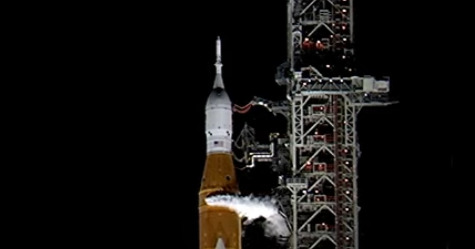
The small white cloud from the SLS here (about two hours before launch) is from fuel boiloff. It is supposed to look like that.
The gas released is still very cold, cooling the air around the valve very quickly. As cold air can hold less water, this creates a huge increase in humidity, producing little droplets of water and create a small cloud around the valve [5].
T-5 seconds (keeping things quiet)¶
Rocket launches are noisy. Sound waves are just vibrations in the air, but the very loudest noises carry enough energy to shake apart buildings. Large rockets need some way of quieting down so they don't shake the launchpad apart (rebuilding it each time would be rather expensive).
The humans in the rocket also don't like very loud noises and given that rockets are often launching delicate scientific equipment or satellites, ideally you want to shake this cargo as little as possible before getting it into space [6]. This is why the launchpad is covered with water a few seconds before launch.
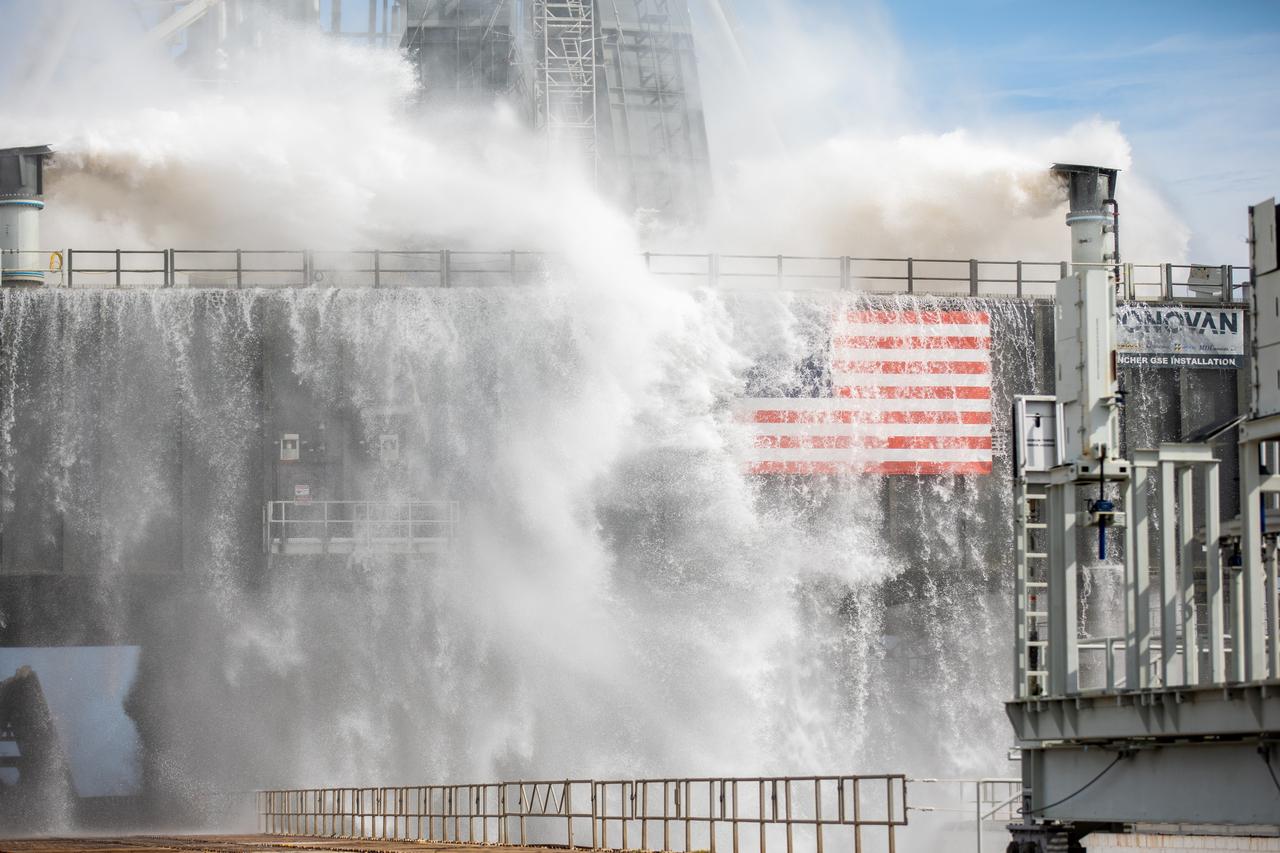
Launch pad 39B covered with water, during a test of the sound suppression system. I imagine they could also use this system for cleaning the pad after a launch (NASA).
Bubbles (and droplets) are excellent absorbers of sound. By spraying water into the air in the few seconds before the launch, a cloud of bubbles is created, absorbing a large fraction of the acoustic energy and turning it to heat. For the Space Shuttle, this reduced the sound in the cargo bay to only 142dB (similar to a jet engine at takeoff).
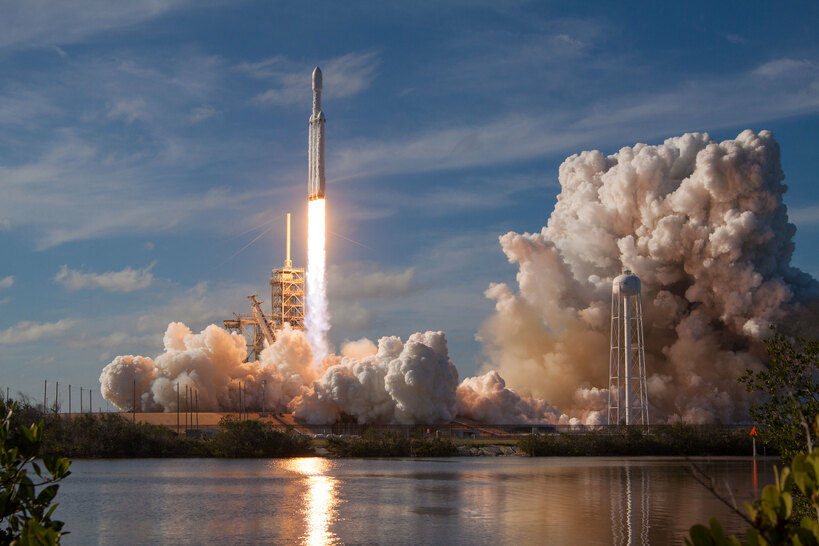
Clouds around the Falcon heavy test launch. These clouds are not rocket exhaust, but water from the sound suppression system being heated as the rocket launches. The Falcon 9 family of rockets typically produce an almost transparent plume. (SpaceX)
These clouds around the launchpad in the moments immediately before and after the launch are steam from the sound suppression system, heated by the rocket engine during launch. The water is blasted out of a trench below the rocket, designed to deflect the energy away from the launchpad, creating a mechanically produced cloud.
T+0 (shaking things loose)¶
As most rockets use very cold fuels, their outsides also cools down while waiting to launch. If it is cold enough, a lot of ice can form on the outside of the rocket. As the engine ignite and the rocket starts to move, this ice gets shaken loose, forming a white shower of ice crystals around the rocket.
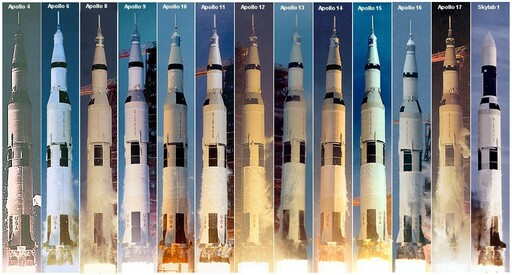
Almost all of the Saturn V launches (particularly Apollo 17, launching on an early December morning) had ice being shaken free during launch forming small clouds around the rocket (Wikimedia/Maldoror).
This depends a lot on the weather on launch day, but is quite common, even in sunny Florida.
T+5 (liftoff)¶
We are now (finally) at clouds formed by the rocket engines themselves!
While there is a big plume of water at liftoff from the sound suppression system, not all rockets leave a plume behind them as they climb into the upper atmosphere. While the Space Shuttle, Ariane 5 and Altas V all leave a plume behind them, the Saturn V, Falcon 9 and Delta IV do not.
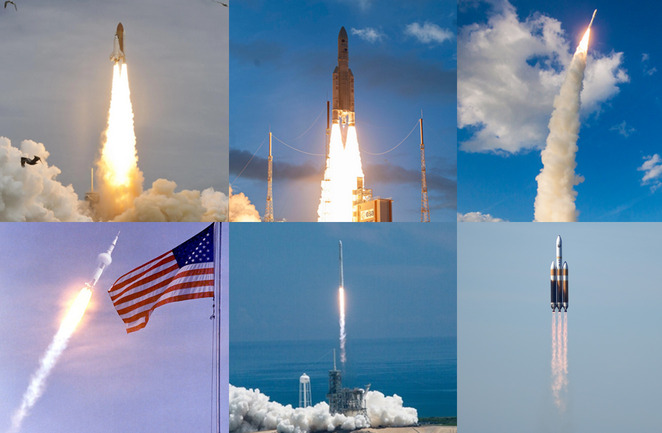
Different types of rockets leaving trails (or not). Top row - Space Shuttle, Ariane 5, Atlas V. Bottom row - Saturn V, Falcon 9, Delta IV.
The difference is due to the fuel type used. All of these rockets use a liquid cryogenic fuel (typically liquid hydrogen or kerosene). These fuels all create water as a byproduct of combustion, but it is not nearly enough to form a cloud in the lower atmosphere [7]. However, the rockets that leave a plume have one big factor in common - they all use solid-fuel rockets as boosters!
These booster rockets burn metal powders (often aluminium), often with an oxidiser such as ammonium perchlorate (\(NH_4ClO_4\)). This produces lots of aluminium oxide as a white powder (\(Al_2O_3\) in the following equation), so the rocket exhaust leaves a visible cloud.
In contrast, liquid fuel engines create many fewer particulates. Liquid hydrogen engines (like the Space Shuttle main engine) hae an exhaust that is almost entirely water. While they are comparatively dirty, kerosene engines (like the Saturn V and Falcon 9) still produce too few particles to leave a thick smoke trail.
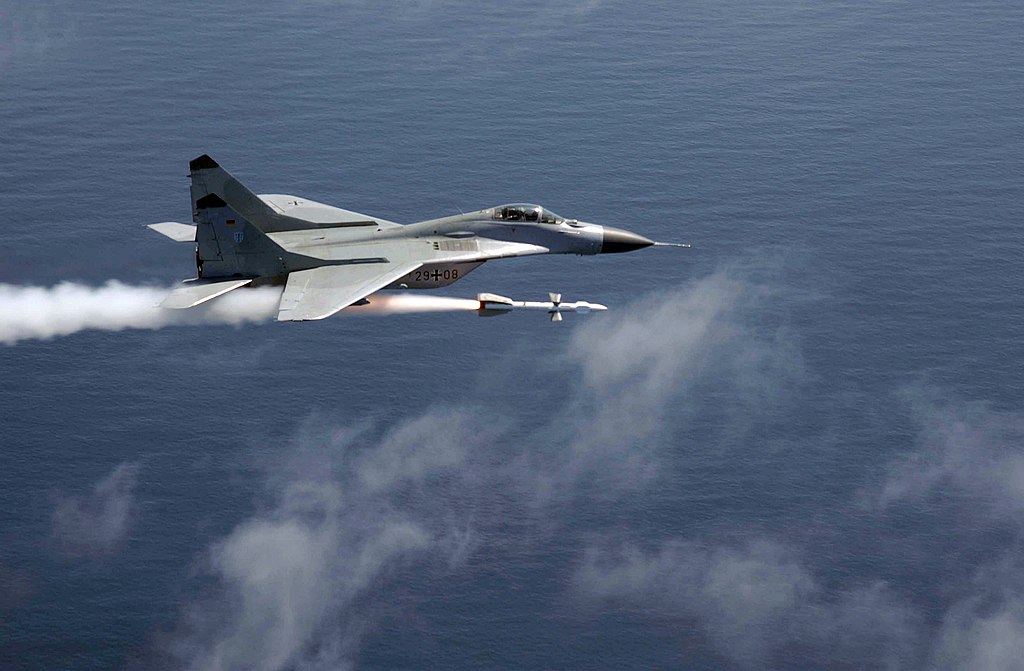
Most other solid rockets produce smoke trails, such as this air to air missile (Wikimedia/USAF).
Solid rockets are used for a wide variety of applications, as they are much easier to store and use than liquid rockets. Smokeless rockets (particularly for missiles) are desirable for some applications, but require using a different fuel [8].
T+30 (the sound barrier)¶
At about 30 seconds after launch, a typical rocket passes through the sound barrier and a new type of cloud forms around the rocket. It only exists for a few seconds, but forms a cloud clinging to the sides of the rocket.
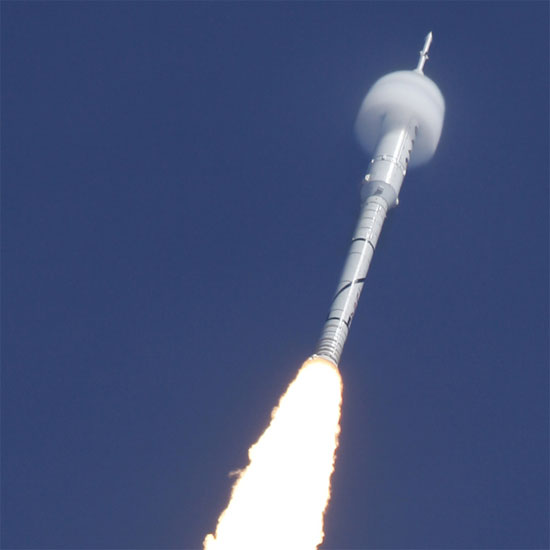
Clouds forming around the top of the Ares1-X rocket a short time after launch (NASA).
This cloud, also known as a vapour cone or a shock collar, occurs as the rocket passes the sound barrier. It is not the shockwave or sonic boom becoming visible though, it is actually the opposite!
As the rocket approaches the speed of sound, air around some parts of the rocket becomes supersonic before others. As the airflow moves from a supersonic to a subsonic region, it expands, which causes the pressure and temperature to drop very quickly. As the colder air can hold less water, the water condenses into droplets, which we then see as a cloud [9]. This happens near convex corners, such as canopies, wings, or solid rocket boosters (such as in this photo of the shuttle).
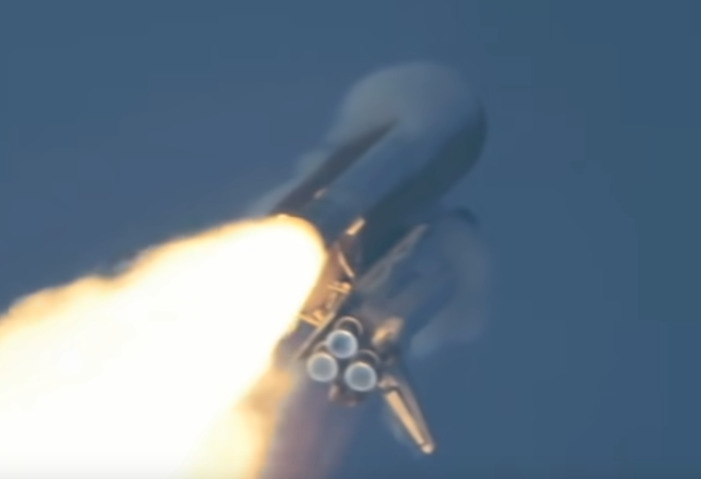
Clouds clinging to the Space Shuttle during launch, caused by pressure changes as the air begins to go supersonic around different parts of the shuttle (NASA).
These kind of clouds can occur in other conditions too - anything that causes air to expand quickly can generate these clouds. Slower moving aircraft, shockwaves from explosions and bottles of beer all produce them, and you can make your own with a bike pump and plastic bottle!
T+2 minutes (rocket contrails)¶
All current rockets produce water from burning their fuel. While this is too little water to produce a cloud lower in the atmosphere, in the cold stratosphere, this water is enough to produce a cloud, even for rockets without solid-fuel boosters. Very cold air can hold much less water than warm air, so the humidity in the air behind the rocket is a lot higher.
This is very similar to the formation of contrails behind aircraft, where the water from combustion in the jet engine mixes with the surrounding air to form a cloud.
You can see these clouds forming clearly in this video of a Falcon9 launch just before sunrise. As the rocket climbs away from the dark surface, it reaches altitudes where the sun is already 'up', illuminating the thin clouds left by the rocket [10].
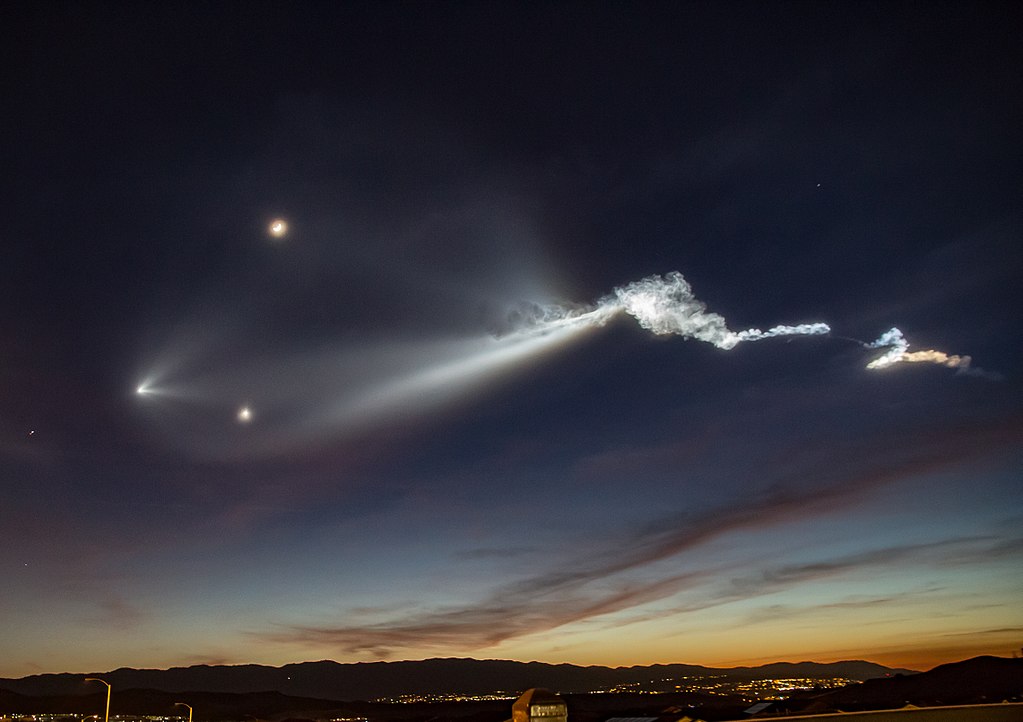
The clouds on the right are in the stratosphere, formed around 100 seconds after launch at an altitude of about 25km. The hazier cloud on the left is at a much higher altitude and is larger because of a different engine used in the second stage of the rocket and the lower pressures high up (Wikimedia).
The extra water added by rockets to the mesosphere (around 80km high) can promote the formation of noctilucent clouds (very high clouds, like these) near the poles, even up to a week later!
While this guide includes lots of clouds, it may not be complete - let me know if you think there are others!
Comments by email
Notes¶
| [1] | Not another boring space launch, quick, change the channel! (The Simpsons) |
| [2] | T is technically part of the countdown sequence, not a real time. If the launch is paused for any reason, the T-minus time stays constant. For us though, this distinction is not important. |
| [3] | You can save even more space by cooling the liquid fuel down further, as SpaceX do with the liquid oxygen on the Falcon 9. Although this saves space, it does make putting fuel in the rocket harder, as you can't just leave the rocket standing around warming up before takeoff like you can with normal liquid oxygen (where you can just keep topping off the tanks with new fuel as it evaporates). |
| [4] | This increase in volume can be hundreds of times - if you don't relieve the pressure, you can quickly get an explosion risk. |
| [5] | You can hear the same thing happening on Earth. If you are ever near a scientific lab (or hospital) with a liquid nitrogen container, it will also have a valve to release the pressure and will usually produce a hissing noise. The noise is a good thing, if the valve gets blocked, the tank has no way to release the pressure and can be an explosion risk. For labs that deal with liquid nitrogen (or helium), this is also something to be careful of. For dewers (the flasks for storing liquid gases) have a pressure meter and an emergency vale to release the pressure. Many of the labs I have worked at have a story (likely apocryphal) or a shotgun, stored somewhere on campus, for use as emergency pressure release for these flasks. |
| [6] | Different rockets shake in different ways, so some instruments are designed to deal with these frequencies for a specific rocket (if you know in advance that is the rocket you will launch on). The James Webb Space Telescope was built like this, specifically designed to launch on the Ariane 5. |
| [7] | For their main engines anyway. Some upper stages and thrusters use other fuels, but even these often burn to generate water. Liquid hydrogen (Space shuttle, SLS) - \(2H_2 + O_2 \rightarrow 2H_2 O\) Kerosene (Falcon 9, Saturn V) - \(2 C_{12}H_{26} + 37 O_2 \rightarrow 24 CO_2 + 26 H_2O\) Methane (planned for the SpaceX Starship, Vulcan) - \(CH_4 + 2O_2 \rightarrow CO_2 + 2H_2 O\) |
| [8] | The problem with making a rocket smokeless is that if you create metal oxide particles, these will leave a smoke trail. You therefore have to burn something other than metal, which reduces the power output of the rocket. |
| [9] | This is very similar to how a natural cloud forms too, just much, much faster. |
| [10] | Here an excellent explanation video from Scott Manley |